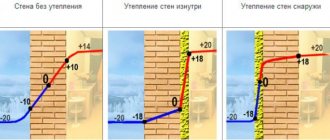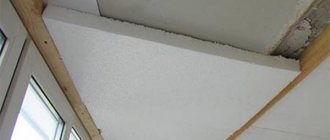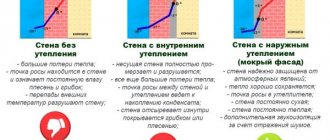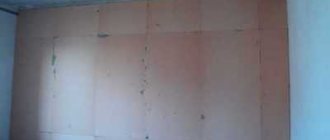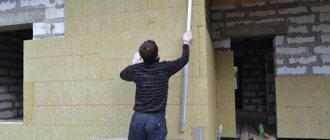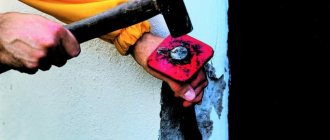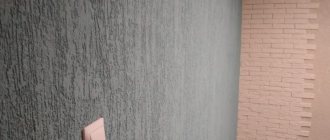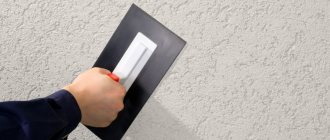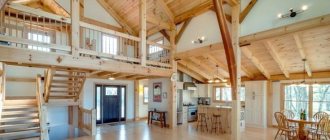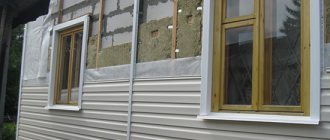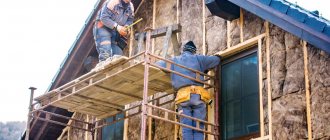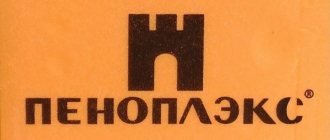A little about polystyrene foam
Installing expanded polystyrene boards under siding is a profitable solution for creating an optimal thermal insulation layer.
In addition, the material has good sound insulation characteristics, is environmentally friendly and is not subject to combustion. Despite the fact that polystyrene foam is not flammable, it melts when exposed to high temperatures or open fire. At the same time, combustion products are released into the atmosphere, which, if they enter the human respiratory system, can cause injuries incompatible with life. Currently, two types of polystyrene foam boards are used in individual construction; any of them can be used to insulate your own home from the outside, followed by finishing for siding:
- Regular foam;
- extruded.
| Type of insulation | Thermal conductivity, W/(m*K) | Water absorption,% | Density, kg/m3 |
| Styrofoam | 0,03 | 0,1-0,2 | 25-35 |
| Extruded polystyrene foam (expanded polystyrene) | 0,028 | 0,3-0,5 | 32-38 |
The table shows the average values of material coefficients; depending on the manufacturer, they may differ slightly from those indicated.
Principles of thermal insulation of facades with expanded polystyrene
The video image shows a facade with expanded polystyrene.
Today, the technology of insulating facades with extruded polystyrene foam has become quite popular and has found application as a thermal insulator in the construction of almost every building.
This heating technology is called wet façade and its application consists of several phases.
If the order of façade design is changed or if one of the classes is omitted, there is no guarantee of high quality and long-term thermal insulation.
The wet-facade closure method is most often used for houses built on cinder, brick and reinforced concrete.
The process of thermal insulation of facades using expanded polystyrene should be carried out with the help of a specialist to monitor the final process.
In this case, it should be noted that it is better to warm up in clear weather, but not too hot.
Otherwise, humidity, high wind or air temperature may damage the structure of the building material between the building parts.
What is a good polystyrene foam as a heater?
Among the obvious advantages of building materials are the following: reduced thermal conductivity, increased humidity for firing properties, high strength and durability, resistance to biological and chemical factors, self-extinguishing ability without damage to the human body and ease of handling.
Reduced thermal conductivity is the most important advantage of any thermal insulation material, since it allows the facade to be insulated with the thinnest polystyrene.
In addition, it offers great comfort in decorating the facade of the house with your own hands.
Increased resistance to moisture from foamed polystyrene allows you to dry up to 94% of the material in the most difficult conditions.
The building material can withstand up to 50 freezing and thawing cycles without damaging its own structure. This quality allows the use of polystyrene foam in regions with predominantly cold climatic conditions.
A structure made of polystyrene foam boards can maintain thermal insulation properties for 60-70 years.
The structure of the material is not affected by climatic conditions; it will never rot under the influence of frost, rain or sunlight.
Fungal or mold bacteria do not endanger the thermal insulation of the façade. In this case, unlike other types of heaters, it does not undergo processing that is harmful to human mixtures.
Therefore, its harmless properties appear as the foam is also used in some types of food products due to its lack of toxicity.
Installation of the plates is very simple as their light weight allows you to work in complete safety.
Features of the material
Polystyrene foam is 98% air, which allows it to retain the maximum amount of heat in rooms. Therefore, this material is used not only for insulating the walls of residential buildings, but also for ceilings, floors, basements, foundations and warehouses.
Is there really one reason why polystyrene foam has become so popular? Not at all. There are other positive qualities inherent in this material.
Advantages
Let's start, as usual, with the advantages, because it is thanks to them that home owners choose polystyrene foam for insulation:
- Sound and thermal insulation of premises.
- Light weight, which helps reduce the load on load-bearing walls. This means that expanded polystyrene is also suitable for very old buildings.
- Versatility of use. It can be used for both interior and exterior work, for residential and non-residential premises.
- Moisture-repellent properties.
- Affordable price. The cost of polystyrene foam is quite low compared to other materials.
- Duration of operation. This advantage can be considered relative, since unprotected foam is quickly destroyed when exposed to sunlight. But if it is covered with facing material immediately after installation, the service life will be up to 30–35 years.
- Safety. The foam is coated with antipyrines, which prevent the heat insulator from smoldering and releasing caustic substances.
- Prevalence. This insulation can be found at any hardware store. At the same time, slabs of different densities and thicknesses are presented at one point.
As we see, there are really a lot of positive aspects, and now it becomes clear why those who want to insulate themselves buy polystyrene foam.
Flaws
Pros are pros, but each material also has several disadvantages. They should not be ignored at all, and sometimes a few disadvantages can outweigh a large number of positive aspects. Polystyrene foam also has its disadvantages:
- fragility. A slab of any density and thickness breaks easily. This must be taken into account during the cutting and installation process; it is advisable to be as delicate as possible with this material;
- low vapor capacity. You should not rely on natural ventilation if the house is lined with foam plastic. Vapors will accumulate in the rooms, and this will lead to a deterioration in the microclimate. This material is categorically not suitable for insulating wooden buildings;
- does not tolerate exposure to ultraviolet radiation and some paints and varnishes;
- if the foam is not coated with fire retardants, it easily ignites and produces acrid smoke;
- love of rodents and birds. Rodents settle in slabs and make their own nests. Birds pick holes in slabs that are not covered with facing material.
Having familiarized itself with all the advantages and disadvantages, the buyer makes his choice whether or not to purchase this insulation.
Types of decorative finishes
When finishing the facade with foam plastic is finished, it’s time to start decorative cladding of the building. It is recommended to decide on the material before you start insulating the facade, but if you haven’t done this yet, then it’s time to start.
Preparing the decorative layer
Primer of walls
The most popular options:
- A simple option is facade plaster (huge selection of colors, water resistance, vapor permeability, simplicity, durability). It happens: mineral, acrylic, silicate, silicone.
- Vinyl siding is inexpensive, easy to install, and one of the most popular coatings.
- Facade panels with patterns. They are made of plastic, metal, wood, aluminum, stone, brick, tile. Installed on the façade sheathing.
- Decorative ceramic tiles - durable, fire-resistant, large selection of colors and sizes.
- Concrete tiles - durability and strength at low cost.
- Facing bricks (ceramics, clinker, hyper-pressed, silicate).
- Artificial or natural stone (marble, sandstone, dolomite, limestone, quartzite).
- Sandwich panels – aluminum, plastic, steel, magnesite sheets. Filling: cotton wool, polystyrene foam.
- Porcelain tiles (high frost resistance, water resistance).
- Facade cassettes are galvanized steel coated with polymer of various shapes.
Applying facade plaster
You can also distinguish wooden (the more common name is lining), foam, metal (it weighs a lot, you need to take into account the load), and cement siding.
Before installing any type of siding, you must first install a ventilation structure into the walls.
Which material to choose depends on personal preference and cost.
Formation of invoice
Pros and cons of insulation from the inside
Before doing the work yourself, you need to study all the nuances. Thermal insulation of indoor walls is not the right solution from the point of view of such a science as heating engineering. This method becomes only acceptable if it is impossible to use another. The disadvantages of insulating the walls of a house from the inside are as follows:
- reduction of usable area of internal premises;
- the measures taken do not prevent the walls from freezing, and therefore do not protect them from destruction;
- the point of dew (condensation) appears inside the load-bearing wall of the house (there is a high probability of moisture accumulation).
The dew point is at the junction of the wall and the foam, so to avoid condensation it is extremely important to apply a vapor barrier
Insulation with foam plastic from the inside can only be done if there is a serious need for it. Most often, DIY work should be done in the following cases:
- Thermal insulation of premises in a multi-storey building. To insulate an apartment with polystyrene foam from the outside, you will need to hire industrial climbers. Such services are expensive, so an alternative option is to use protection from the inside.
- Insulation of house walls with new cladding. When doing work with your own hands in a private house, it is necessary to take into account the condition of the facade finishing. If the external work was completed relatively recently, dismantling the cladding is not practical from an economic point of view. In this case, it is also possible to fix the thermal insulation from the inside of the walls.
Myth No. 8. Decorative plaster over insulation is not necessary - just paint is enough
The protective properties of painting can be defined as follows: good protection against temperature changes and chemical influences. However, this cannot be compared with the protective properties of reinforcing layers and plaster. The reinforcing mesh will first ensure the strength of the system and prevent further cracking of the plaster, and the plaster itself will protect the foam from ultraviolet radiation and mechanical damage. The facade will retain its attractive appearance for many years. In addition, you can paint and repaint it in any color.
Styrofoam harbors mice
And one more fact that needs to be pointed out when assessing the pros and cons of foam insulation is that mice breed in the material.
Expanded polystyrene is an ideal habitat for them, because it is warm and soft. Therefore, when insulating with polystyrene foam, block the access of mice. To do this, you can finish the places where rodents can enter with mineral wool, which mice do not like.
Therefore, although polystyrene foam has a number of positive qualities, we should not forget about its disadvantages. Therefore, it should be used thoughtfully and in accordance with all the technological features of the material.
How to properly insulate a house with foam plastic from the outside
Everyone knows that a significant percentage of heat loss occurs on the walls of the house, especially if they are not insulated. In this case, even a modern and efficient heating system will not cope with high-quality heating of the room. If you know how to insulate the outside of a house with foam plastic with your own hands, you can save a lot and not need to hire a specialist.
Advantages of external wall insulation with foam plastic
Insulating a house from the outside can be done in two ways: outside and inside. Experts advise carrying out work from the street side, in this case:
- the usable space of the house is preserved;
- there is no need to perform an additional layer of vapor barrier;
- a multilayer structure is provided that prevents moisture from entering the room;
- the heat-saving properties of the house increase, which allows you to save money by reducing heating costs.
Which polystyrene foam is better to insulate a house?
You may be wondering whether it is possible to insulate a wooden house with polystyrene foam, and also how much such insulation costs. Wooden houses, just like ordinary ones, need insulation. The heat will quickly escape through the timber, which means the house will become uninhabitable in the winter. The price of insulation depends on the size of the house, as well as which company you use. You can save money by insulating the outside of your home yourself.
How to choose polystyrene foam for cladding a house? For insulating facade work, the best option is foam in the form of sheets, the thickness of which is at least 10 cm. Knowing how thick the foam is to insulate the outside and inside, you can achieve good results and save on heating your home.
There are 2 types of foam:
- Fragile. This material breaks and crumbles easily.
- Building. It is very dense, but at the same time light. It cannot be pushed.
Both types are excellent for insulation work: the denser one retains heat well, while the porous one can withstand distortions and is cheaper.
Find out how to insulate the walls of aerated concrete houses
Positive properties of polystyrene foam for external insulation
- ease of use, easy attachment to the surface;
- affordable price;
- seismic resistance;
- not subject to rotting;
- high heat-saving characteristics.
The disadvantages of foam insulation are as follows:
- It is an artificial material, so environmental friendliness is questionable.
- Flammable.
- During the combustion process, harmful substances are released;
- Mice really liked it as a place to live.
Step-by-step instructions for insulating the exterior of a house on your own
It will be useful at work:
- sheet foam;
- fasteners;
- assembly adhesive;
- reinforced mesh;
- putty;
- primer;
- drill;
- sharp knife;
- spatulas;
- hammer.
Step 2: preparing the walls
Step 3: foam installation
If the outside wall of the house has been properly prepared, then the process of gluing the foam sheets will take a little time. The glue is applied to the sheet using a spatula, the excess is removed with a notched spatula. Additionally, glue is applied to the wall surface. A sheet of foam plastic is carefully applied to the wall and lightly tapped to secure it.
Step 4: fixation with nails
The external surface of the house is left for 3 days for the glue to dry, after which it is secured with special type of nails. They are hammered along the edges and, for reliability, one in the center.
Step 5: Gluing the mesh
A layer of glue is applied to the foam, then a mesh is applied. Using a spatula, you need to smooth it out and add adhesive if necessary. First, the mesh is stretched over the corners, then distributed over the entire surface. From the edge you need to leave 10 cm of mesh without glue, for joining with the next layer. When the surface dries, sand it down and apply finishing putty or decorative plaster on top.
As you can see, the technology for insulating the facade of an ordinary or log house with polystyrene foam is simple, and if carried out correctly it will give tangible results. Now you know how to carry out external insulation of a house with polystyrene foam with your own hands and you can decide for yourself whether it is worth insulating with this material or not.
Preparing the wall surface
The wall surface must meet the following requirements:
- No loose plaster.
- No old paint.
- The surface of the wall should be stable and not crumble when you run your hand over it.
- The plane of the wall must be flat, the maximum difference is 1-2 cm. Deeper depressions must be plastered or sealed.
If necessary, the wall is plastered or coated with a deep penetration primer (if it is very crumbling).
Surface preparation
What do you need for work?
Before proceeding with the installation of foam plastic, the necessary materials and tools are purchased and prepared.
Materials:
- Styrofoam;
- Adhesive composition suitable for the material;
- Polyurethane foam;
- Dowels;
- Primer and plaster;
- Construction mesh for reinforcement;
- Starting bar.
Tools:
- Drill (it’s good if you have a mixer attachment);
- Notched trowel for applying adhesive;
- Regular spatulas;
- Construction knife;
- Container for diluting glue;
- Roulette;
- Level;
- Drill;
- Graters with teeth of various sizes.
It is important to purchase the “correct” polystyrene foam to insulate walls. To do this, its density should be about 25 kg per cubic meter
The thickness of the slabs should be at least 8 cm, most often 10 is used.
You can attach the foam with glue or dowels. But as practice shows, both are better. The pasted sheets are fixed in several places with nails for greater strength.
If desired, a starting profile profile is installed at the bottom of the wall, which serves to secure the position of the sheets and prevents them from sliding during installation. It also prevents damage to the foam by rodents, so if there is a problem with uninvited guests visiting, then it is better to use it.
Installation of the starting profile
After all the preparatory work regarding the surface of the walls, so that the first row when insulating the facade with extruded polystyrene foam is installed correctly, it is necessary to install the starting profile. For this design, you can use a metal profile for working with plasterboard or a special plinth. The width of the load-bearing support must be selected according to the thickness of the slab of insulating material.
The starting metal profile is attached along the entire perimeter of the facade using a dowel fastening (the dowel is driven in at a distance of 30 cm), and the horizontal plane is controlled by the building level.
Figure 4. Beginning of installation
And so as not to doubt the correct vertical arrangement of the sheets? It is advisable to install plumb lines every 50-60 cm; a nylon thread with a weight attached to one end is ideal for this.
Advantages of the material
Despite its cheapness, polystyrene foam is a high-quality and safe material. Information about toxicity is just a myth. The main property due to which it is actively used in house cladding is its high thermal insulation qualities.
The material also has many more advantages:
- High noise insulation properties.
- Light weight, which reduces the load on the foundation and walls.
- The material is water-resistant and does not deform in high humidity.
- Does not ignite.
- Durable and does not lose its properties for about 50 years.
- Prevalence and accessibility. You can buy polystyrene foam at any hardware store.
But all these advantages apply only to high-quality material and with proper installation. How to properly cover a house with polystyrene foam?
Myth No. 3. It doesn’t matter what you use for insulation.
The most wrong opinion that could ever be thought up or expressed. Your comfort will depend on the quality of the material in the future. Therefore, before choosing it, remember a few important rules:
- choose material from trusted, well-known manufacturers;
- the polystyrene foam you choose must be produced in a factory that provides certification for its products. This way you will receive quality material;
- the reinforcing mesh should not have low density, be fragile or too cheap;
- facade dowels (fungi) must be made of good plastic, flexible, frost-resistant, elastic, and also be at least 50 mm longer than the foam;
- decorative plaster and paint applied to it must be of high quality.
